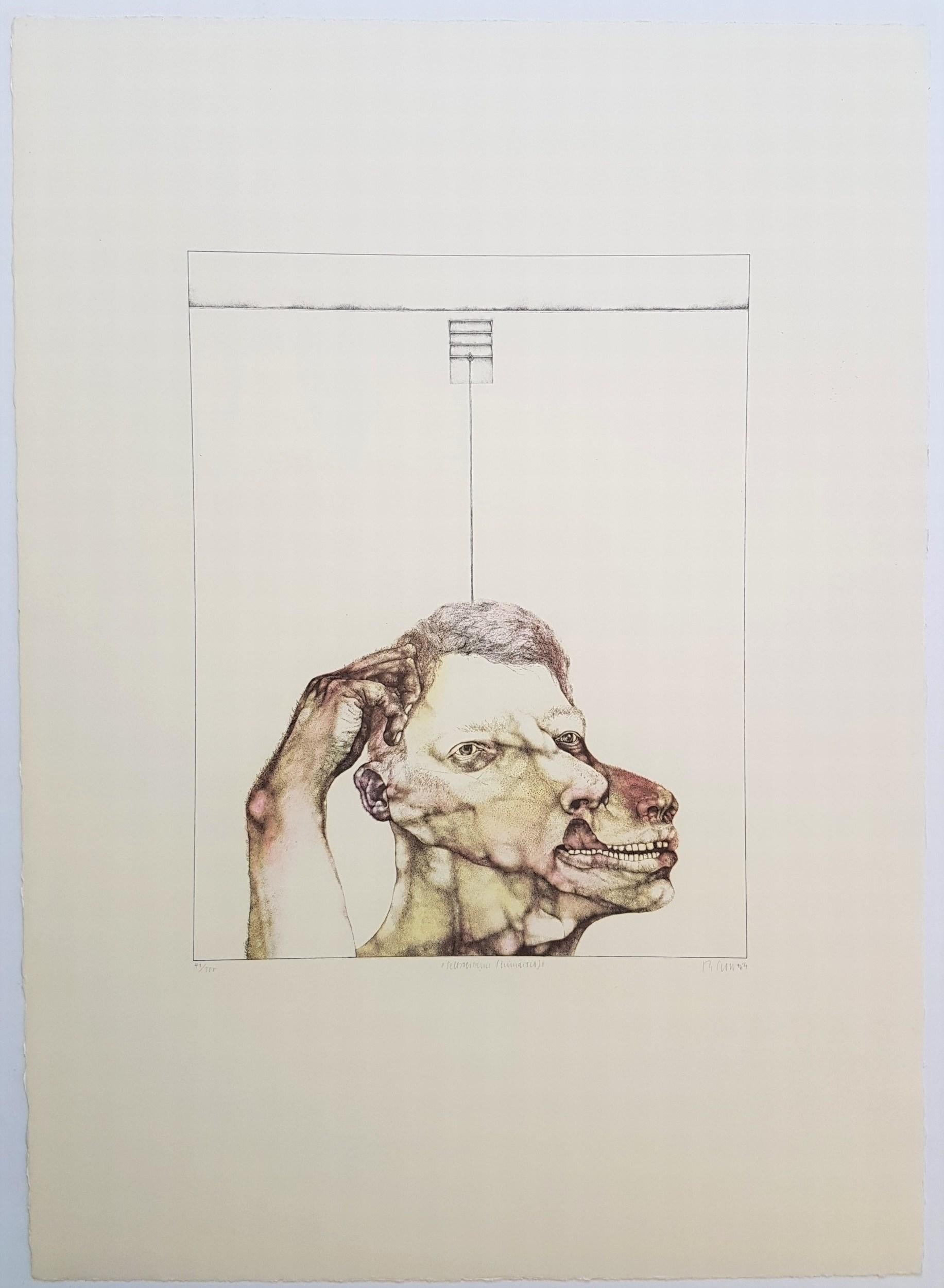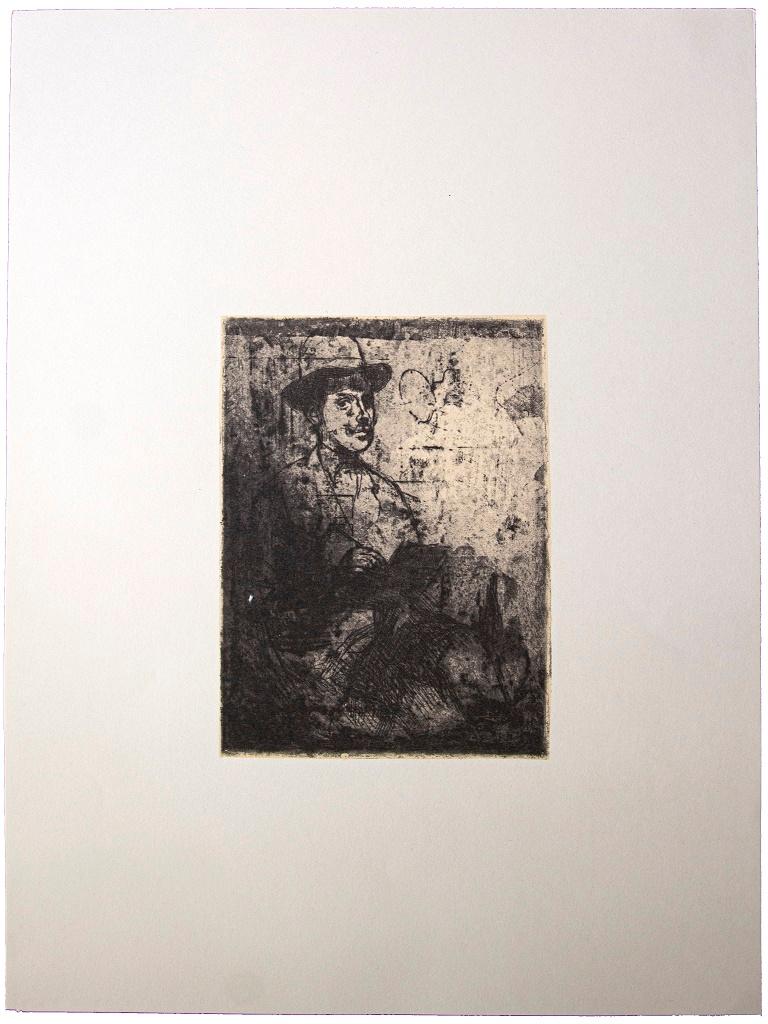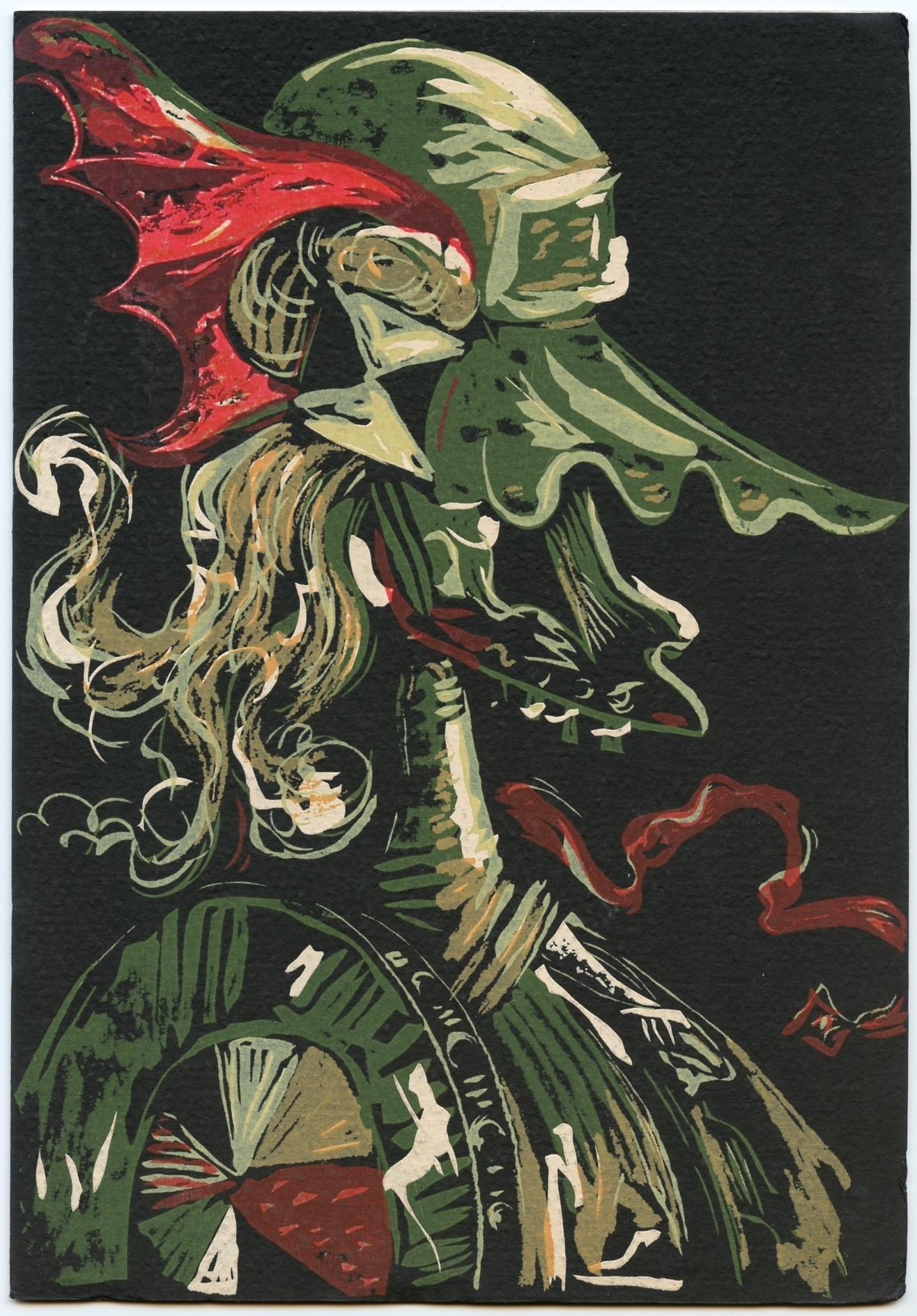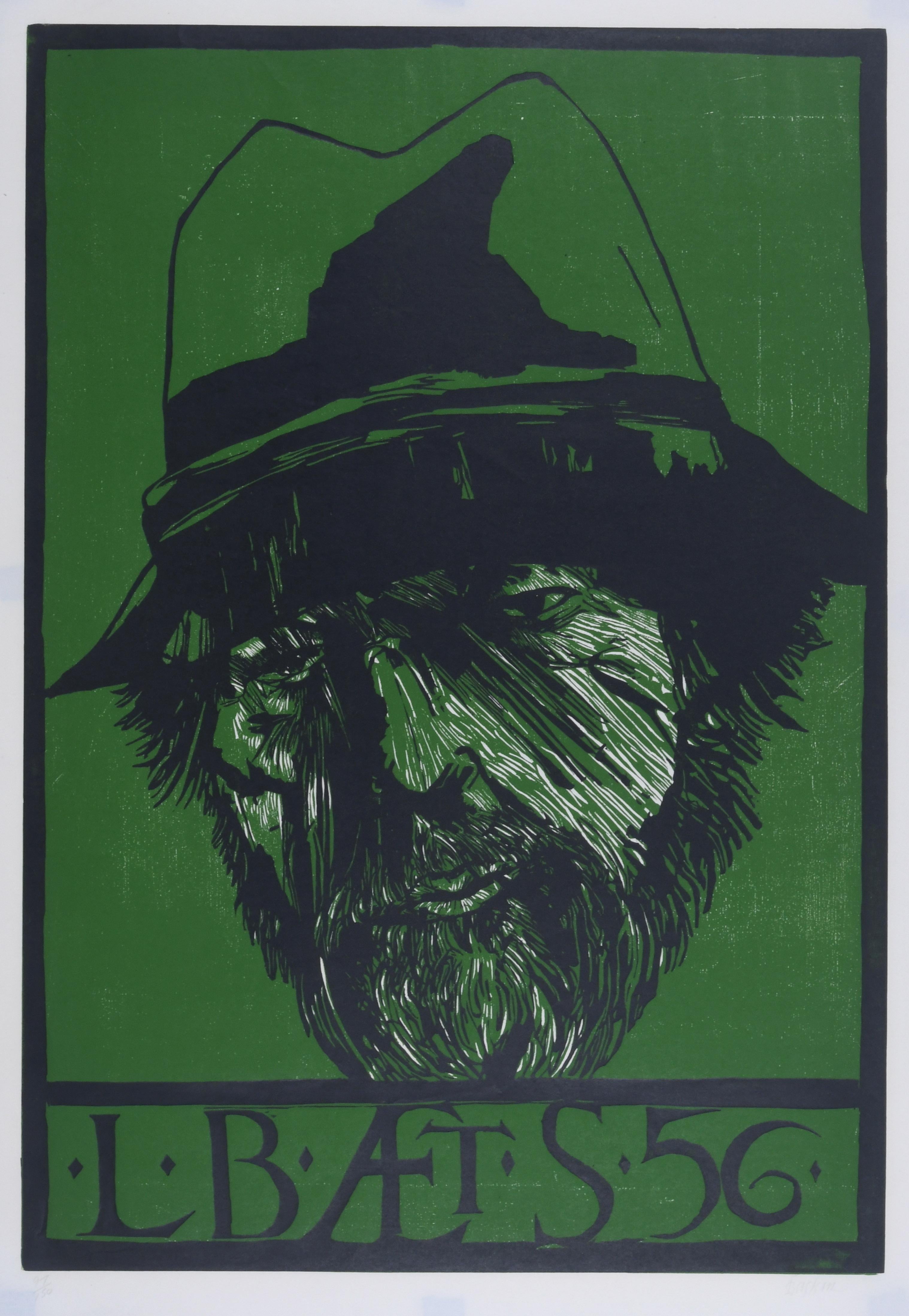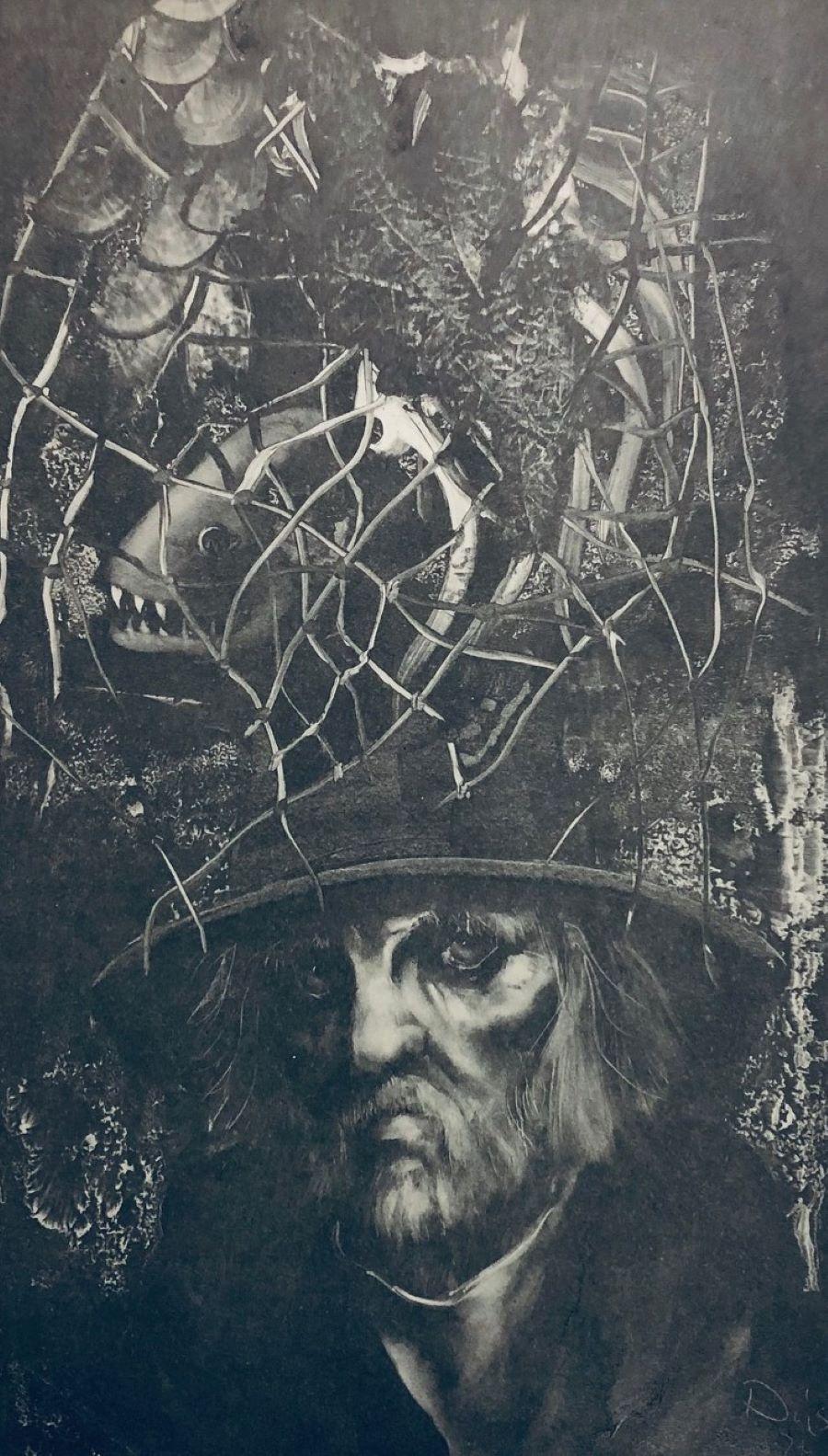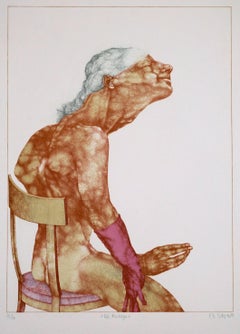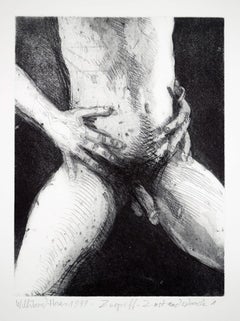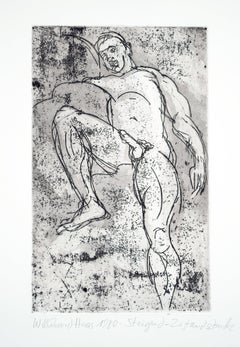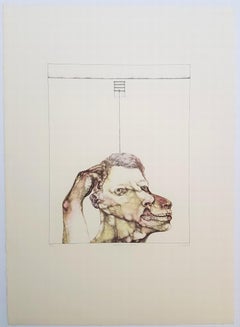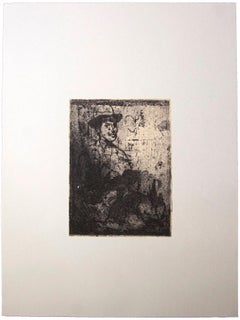Items Similar to Self / - Inversion -
Want more images or videos?
Request additional images or videos from the seller
1 of 7
Kurt MühlenhauptSelf / - Inversion -
$334.66
£250.26
€280
CA$461.39
A$506.39
CHF 266.12
MX$6,025.95
NOK 3,401.75
SEK 3,108.53
DKK 2,133.72
About the Item
Kurt Mühlenhaupt (1921 Klein Ziescht - 2006 Berlin), Myself, c. 1975. Woodcut, 32 cm x 29 cm (image), 36.5 cm x 32.5 cm (sheet size), signed in pencil lower right and titled “Selbst.” in the center.
- the right margin area somewhat bumped, slight traces of creasing
- Inversion -
Kurt Mühlenhaupt depicts himself as a black figure transcending the black picture frame. By doing so, he reverses the aesthetics of the woodcut. Instead of forming the lines of the otherwise bright face, the areas left standing are worked into the wood, giving the face an overall black appearance. This "anti-aesthetic," characteristic of Mühlenhaupt's art, introduces a new kind of realism to the picture. The eyes, beard, and cigarette stand out against the darkness, portraying Mühlenhaupt as an alert observer of a dark world.
About the artist
Kurt Mühlenhaupt was born and raised in a leafy colony in the Tempelhof district. He initially completed an apprenticeship as a model maker. After being drafted into the Wehrmacht, he was wounded in the war. In 1943, he took Emmi Stahlmann's art course at the West Private Art School. During the final days of the war, he was called up again, this time as a "cripple," and was wounded once more, leaving a lifelong mark on him. From 1946 to 1949, Mühlenhaupt studied at the University of the Arts Berlin under Maximilian Debus. After Karl Schmidt-Rottluff rejected him, Mühlenhaupt experienced a deep crisis that led to his admission to the Buch mental hospital. After being released, he earned a living by breeding animals until opening a junk store in 1958. The following year, he opened the artists' pub "Leierkasten" in Kreuzberg. Starting in 1963, he organized picture markets in front of his store, which evolved into the Kreuzberg art market. In 1965, he set up a printing press, and by 1969, he was living exclusively off of art. In 1971, he founded the group of Berlin painter-poets with Günter Grass, Aldona Gustas, Robert Wolfgang Schnell, and Wolfdietrich Schnurre. He acquired several farms to use as studios and moved to Bergsdorf-Zehdenick in 1990, where the Mühlenhaupt Museum is located today.
GERMAN VERSION
Kurt Mühlenhaupt (1921 Klein Ziescht - 2006 Berlin), Selbst, um 1975. Holzschnitt, 32 cm x 29 cm (Darstellung), 36,5 cm x 32,5 cm (Blattgröße), rechts unten in Blei signiert und mittig mit „Selbst.“ betitelt.
- der rechte Randbereich etwas bestoßen, leichte Knickspuren
- Inversion -
Kurt Mühlenhaupt stellt sich hier selbst als schwarze Figur dar, die den ebenfalls schwarzen Bildrahmen übersteigt. Damit kehrt er die Ästhetik des Holzschnitts um. Die stehengelassenen Flächen bilden nicht die Lineaturen des ansonsten hellen Gesichts, vielmehr werden die das Antlitz charakterisierenden Linien in das Holz eingearbeitet, so dass das Gesicht im Gesamten schwarz erscheint. Diese für Mühlenhaupts Kunst programmatische ‚Anti-Ästhetik‘ setzt einen ganz neuen Realismus ins Bild, bei dem die Augen, der Bart und vor allem die Zigarette aus dem Dunkel aufstrahlen und Mühlenhaupt als wacher Beobachter einer düsteren Welt erscheint.
zum Künstler
In einer Laubenkolonie im Bezirk Tempelhof aufgewaschen, absolvierte Kurt Mühlenhaupt zunächst eine Lehre als Modellbauer. Nach seiner Einberufung zur Wehrmacht wurde er im Krieg verwundet. 1943 besuchte er den Kunstkurs von Emmi Stahlmann an der privaten Kunstschule des Westens. In den letzten Kriegstagen abermals als ‚Krüppel‘ eingezogen wurde er erneut verwundet, was ihn lebenslänglich prägte. Von 1946 bis 1949 studierte Mühlenhaupt an der Hochschule für Bildende Künste Berlin bei Maximilian Debus. Die Zurückweisung von Karl Schmidt-Rottluff stürzte ihn in eine tiefe Krise, die zur Einweisung in die Nervenheilanstalt Buch führte. Wieder entlassen, bestritt er seinen Lebensunterhalt mit der Tierzucht bis er 1958 einen Trödelladen und im Folgejahr das Künstlerlokal ‚Leierkasten‘ in Kreuzberg eröffnete. Ab 1963 veranstaltete er vor seinem Laden Bildermärkte, aus denen der Kreuzberger Kunstmarkt hervorging. 1965 richtete er sich eine Druckpresse ein und lebte ab 1969 ausschließlich von der Kunst. 1971 gründete Mühlenhaupt zusammen Günter Grass, Aldona Gustas, Robert Wolfgang Schnell und Wolfdietrich Schnurre die Gruppe der Berliner Malerpoeten. Er erwarb verschiedene Bauernhöfe, die er als Atelier nutzte und zog 1990 nach Bergsdorf-Zehdenick, wo sich heute das Mühlenhaupt-Museum befindet.

About the Seller
5.0
Vetted Professional Seller
Every seller passes strict standards for authenticity and reliability
Established in 2014
1stDibs seller since 2023
23 sales on 1stDibs
- ShippingRetrieving quote...Shipping from: Berlin, Germany
- Return Policy
More From This Seller
View AllMy treasure, my sanctuary / - A Tortured Treasure -
Located in Berlin, DE
Johannes Heisig (*1953 Leipzig), "My treasure, my sanctuary" - To the Christmas Oratorio by Johann Sebastian Bach. Lithograph on strong yellowish laid paper with watermark, 53 x 39.5...
Category
1980s Abstract Expressionist Figurative Prints
Materials
Lithograph
The Hunchback / - Strange beauty -
By Reiner Schwarz
Located in Berlin, DE
Reiner Schwarz (*1940 Hirschberg), The Hunchback, 1969. Lithograph, 33 cm x 22 (depiction), 59 cm x 42 cm (sheet size), signed “R.[einer] Schwarz” in pencil lower right, dated “[19]6...
Category
1960s Surrealist Figurative Prints
Materials
Paper
Access
Located in Berlin, DE
Willibrord Haas (*1936 Schramberg), Access, 1979. etching, 40 cm x 30 cm (plate size), 54 cm x 37.5 cm (sheet size). Signed “Willibrord Haas” in pencil by the artist, dated “1979”, t...
Category
1970s Realist Nude Prints
Materials
Paper
Rising
Located in Berlin, DE
Willibrord Haas (*1936 Schramberg), Rising, 1980. Etching, 35 cm x 22 cm (plate size), 53.5 cm x 38 cm (sheet size). Signed “Willibrord Haas” in pencil by the artist, dated “1980”, t...
Category
1980s Realist Nude Prints
Materials
Paper
Reproachful
Located in Berlin, DE
Willibrord Haas (*1936 Schramberg), Reproachful, 2010. etching, 33.5 cm x 20 cm (plate size), 54 cm x 37.5 cm (sheet size). Signed “Willibrord Haas” in lead by the artist, dated “201...
Category
2010s Realist Nude Prints
Materials
Paper
The Prophet / - The Burden of the Prophet -
Located in Berlin, DE
Wilhelm Gross (1883 Schlawe - 1974 Oranienburg-Eden), The Prophet, c. 1955. Woodcut on thin laid paper, 43 cm x 23 cm (depiction), 61 cm x 43 cm (sheet size), signed “Dr. Wilh.[elm] Gross” in pencil lower right, inscribed “Orig.[inal] Holzschnitt (Handabdruck)” lower left and inscribed “Aus der ”Ecce homo“ Folge” in the center.
- The wide margin with traces of pressing due to the impression, the sitter's left foot with a small purple stain, otherwise in vibrant condition.
- The Burden of the Prophet -
The large-format woodcut shows a prophet figure that takes up almost the entire height of the sheet. However, instead of seeing something in the distance that is still hidden from our eyes - as is usual in depictions of prophets - the figure has raised his hands in a defensive gesture, as if the prophet is trying to ward off what he has seen. At the same time, however, the position of the arms is an acceptance of the inevitable, which only those who recognize what is to come will have to bear for the time being, which is why the figure in the painting - despite its size - appears almost solitary, alone and exposed to the burden of suffering.
In a manner reminiscent of the folds of medieval wooden sculptures...
Category
1950s Realist Figurative Prints
Materials
Paper
You May Also Like
Selbstbildnis (huendisch)
By Reiner Schwarz
Located in Kansas City, MO
Reiner Schwarz
"Selbstbildnis (huendisch)"
From Portfolio "Portrait #11 - Reiner Schwarz" with Karin Szekessy
Year: 1972
Medium: Color Lithograph
Edition: 100
Size: 23.9 x 16.6 in.
P...
Category
1970s Surrealist Prints and Multiples
Materials
Lithograph
$300 Sale Price
40% Off
Selfportrait of the Artist - Offset after F. Gentilini - Mid-20th Century
By Franco Gentilini
Located in Roma, IT
Selfportrait of the Artist is a vintage offset print realized after Franco Gentilini.
The artwork is in very good conditions, no signature, on a white cardboard.
Franco Gentilini (...
Category
Mid-20th Century Contemporary Figurative Prints
Materials
Offset
Untitled I
By Francisco Maringelli
Located in San Francisco, CA
This artwork titled "Untitled I" 1995 is an original woodcut on thin Japan paper by Brazilian artist Francisco Jose Maringelli, b.1959. It is hand signed and numbered 1/30 in pencil by the artist. The image (block mark) size is 13.85 x 8.75 inches, sheet size is 20.5 x 16.25 inches. It is in excellent condition, has never been framed.
About the artist:
Education:
Bachelor Fine Arts, ECAUSP (1984-1989) and Architecture FAUUSP (1979-1985).
Professor at Centro Universitário Belas Artes de São Paulo
Main Exhibitions:
2018 CONTRAGOLPES; obras recentes de Biba Rigo, Cláudio Caropreso e Francisco Maringelli, São Paulo(SP)
Graphias quinze anos, São Paulo(SP)
2017 ROSTOS LAVRADOS-XILOGRAVURAS,Museu Casa da Xilogravura, Campos do...
Category
Late 20th Century Expressionist Figurative Prints
Materials
Woodcut
(after) Kurt Seligmann - pochoir
By Kurt Seligmann
Located in Henderson, NV
Medium: pochoir (after the painting). This exquisitely rich impression on black wove paper was published in 1941 by the Nierendorf Gallery, of New York, for the cover of a now quite ...
Category
1940s Surrealist Figurative Prints
Materials
Lithograph
Self Portrait-L.B. AET 56
By Leonard Baskin
Located in Fairlawn, OH
Self Portrait-L.B. AET 56
Color woodcut printed in black and green, 1978
Signed in pencil lower right (see photo)
Edition: 150 (97/150)
Condition: Excellent
Image: 32 x 22”
Sheet: 35...
Category
1970s American Modern Figurative Prints
Materials
Woodcut
(Title Unknown) Man-Limited Edition Print, Signed by the Artist
Located in Chesterfield, MI
Limited Edition Lithograph (available is multiple editions and AP-Artist Proof). Pencil-signed, numbered and dated by the artist. Good/Fair Condition.
Category
1970s Portrait Prints
Materials
Lithograph
More Ways To Browse
Chagall The Red Rider
Chagall Violin
Clerice Freres
Clint Eastwood Poster
Cowboy Etching
Cyrus Leroy Baldridge
Dali Alice Adventures
Dali Archangel
Dali Curie
Dali Demons
Dali Divine Comedy Woodcuts
Dali Immaculate Conception
Dali King David
Dali Litho
Dali Lithograph Cosmos
Dali Lobster
Dali Logician Devil
Dali Marguerite
